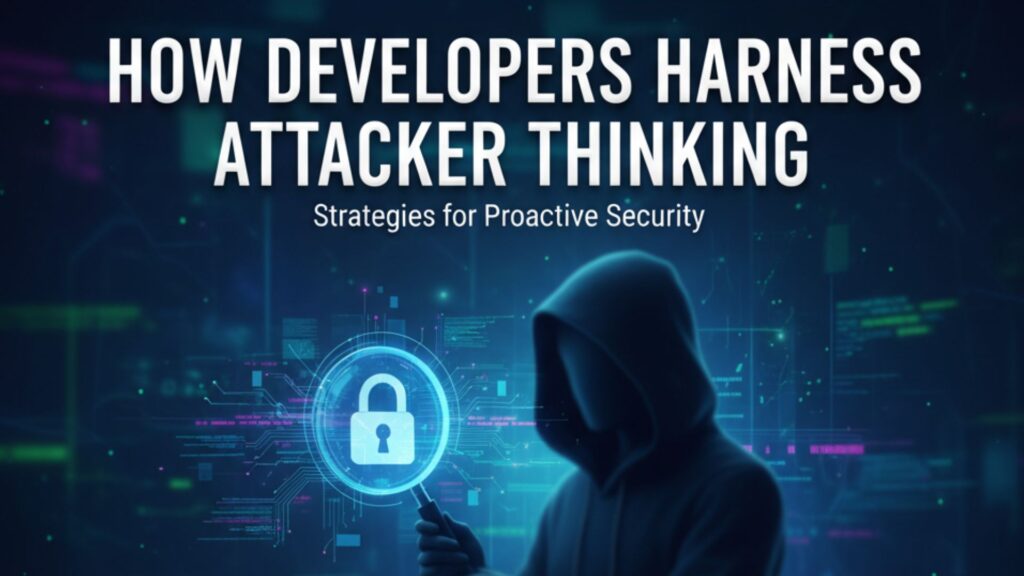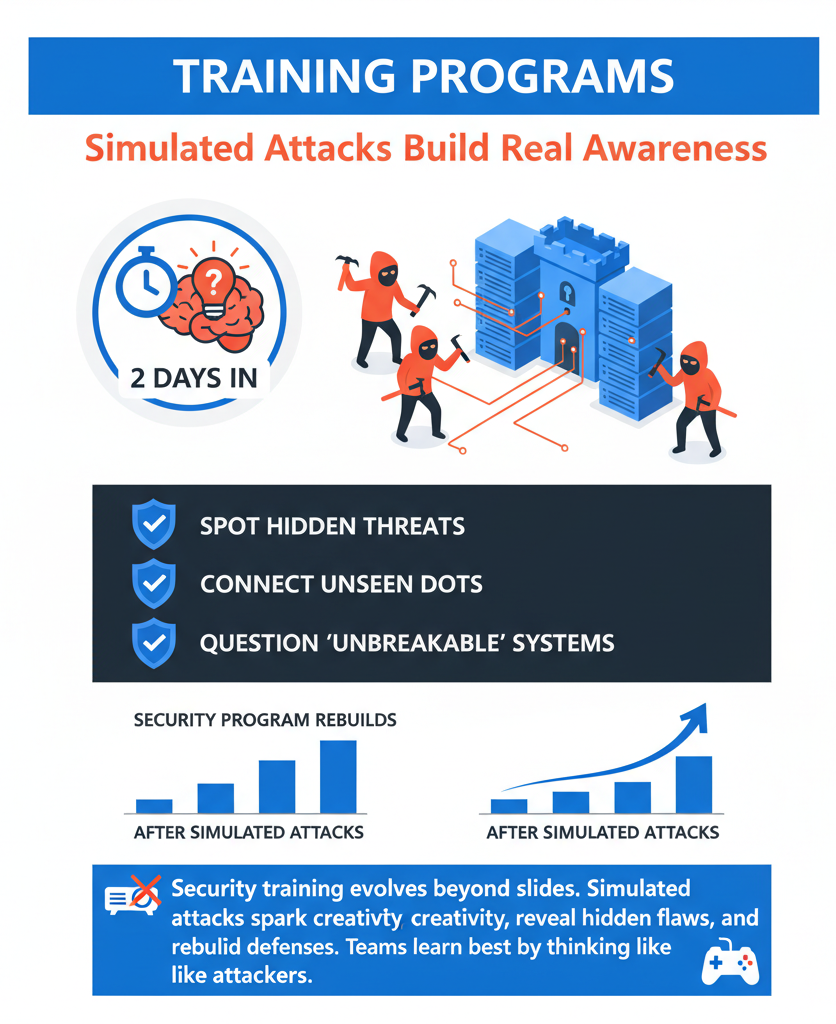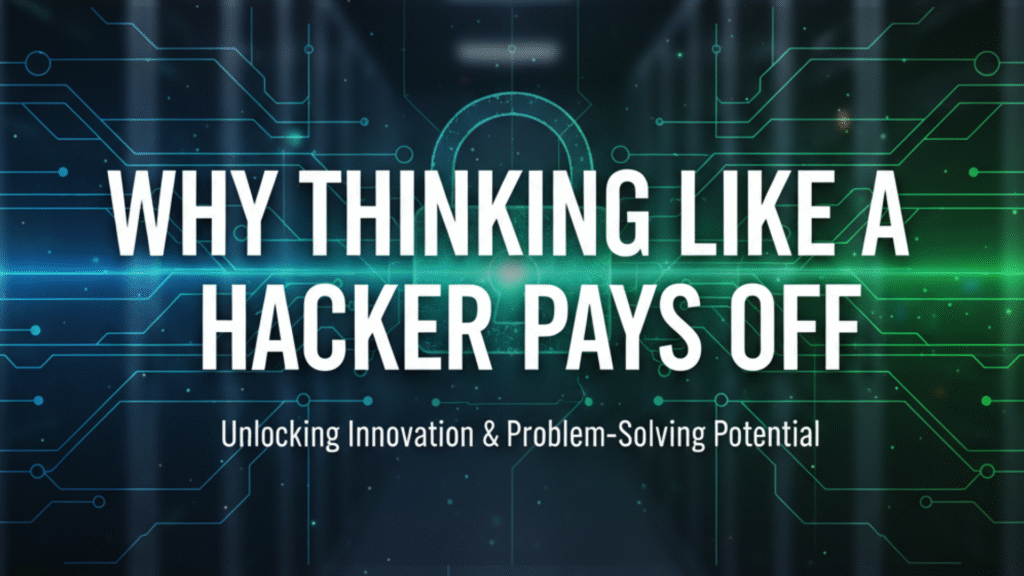
Picture an attacker sitting at their keyboard late at night, scanning networks with tired eyes. That’s what security professionals need to do – crawl inside the mind of someone who’s dead set on breaking through defenses. Our bootcamp team’s spent years watching students transform when they flip their mindset from defense to offense.
They spot gaps nobody saw before, question “secure” systems that seemed bulletproof. The old checklist approach? Not enough anymore. Security teams need this perspective shift badly. Want to see how deep this rabbit hole goes? Keep reading – you might be surprised what’s hiding in plain sight.
Key Takeaways
- When you think like an attacker, you’ll spot the weak spots others miss.
- Getting inside a hacker’s head helps teams catch problems before they become breaches.
- Breaking old habits and thinking sideways – that’s how you build stronger code.
Understanding the Attacker Security Mindset
Nobody wants to admit it, but security’s just an endless game of hide and seek. There’s always someone out there probing, testing, looking for that one mistake we all hope we didn’t make. Our bootcamp students learn this the hard way – you can’t just build walls and hope they hold.
The real magic happens when developers stop playing defense. We’ve watched hundreds of students’ faces light up when they finally get it. That moment when they stop thinking about protecting code and start thinking about breaking it. Something clicks. Systems they thought were solid suddenly look like Swiss cheese.[1]
You wouldn’t believe some of the stuff we’ve caught in our training sessions. Last month’s class found three major holes in what looked like airtight code. All because they asked “What if?” instead of “What should?” The questions sound simple, but they change everything.
Here’s what makes attackers tick:
- They’re like dogs with bones – they don’t give up until they find something
- They think sideways, looking for weird ways to make systems break
- They don’t trust anything – not even their own assumptions
- After a while, they can smell trouble coming – they’ve seen the patterns before
How Developers Harness Attacker Thinking

Look, coding’s not just about making stuff work anymore. Our grads quickly realize the importance of security mindset coding, that writing clean code means thinking dirty first, anticipating how an attacker would try to break it. Every day we watch developers’ eyes open wide when they realize security isn’t just some checklist they tick off at the end.
Last month’s class spent three days breaking into their own apps. They found holes nobody saw coming. That’s when it clicked – threat modeling isn’t some fancy term, it’s survival. Most coders wait until something breaks. Smart ones? They’re already three steps ahead, mapping out where things could go wrong.
Here’s what works in the real world:
- Question everything – especially the stuff that “always works”
- Build in guards against the weird stuff (yeah, someone will try to upload a 2GB image)
- Get other eyes on the code, but not just for style points
- Think like someone who wants to wreck your day
Organizations Gain Proactive Defense and Reduced Breach Risk
Nobody likes talking about breaches until they’re knee-deep in one. Trust us, we’ve seen enough cleanup operations to fill a book. Companies that get it right don’t wait for trouble – they go looking for it.
Our most successful clients run attack simulations monthly. Not those fake, staged ones where everyone knows what’s coming. Real, messy scenarios that make people sweat. It’s amazing what teams spot when they’re thinking like the bad guys.
Sometimes it’s the small stuff that bites hardest. Third-party vendors with weak passwords. That forgotten IoT camera in the lobby. The printer network nobody updated since 2019. When organizations start seeing through an attacker’s eyes, these blind spots light up like Christmas trees.
Training Programs: Simulated Attacks Build Real Awareness

Security training used to mean death by PowerPoint. Not anymore. Our red team exercises go beyond slideshows, a security mindset training program forces teams to break into their own systems and learn the hard lessons attackers already know. Want to see a security team wake up? Tell them to break into their own network.
There’s this thing that happens about two days into training. People stop following their usual patterns. They get creative. Sneaky, even. That’s when the real learning starts. We’ve watched entire teams rebuild their security programs from scratch after seeing how easy it was to slip through their defenses.
Some folks think you can’t teach this stuff. They’re wrong. Give a team permission to think like attackers, and watch what happens:
- They spot the weird stuff conventional scans miss
- They start connecting dots nobody else sees
- They question everything – especially the “unbreakable” parts
The lessons stick because they hurt a little. Nothing teaches quite like discovering your “perfect” system has a backdoor you never noticed.
Embedding Continuous Vigilance in Security Culture
Most folks think security’s about fancy tools and expensive software. They’re dead wrong. Walk into our bootcamp, and you’ll hear stories about million-dollar systems cracked by simple mistakes. That’s why we hammer home one point: paranoia isn’t just healthy, it’s necessary, and cultivating a security mindset keeps teams sharp enough to catch what others miss
Teams who’ve been through our training don’t just patch holes anymore. They’re constantly prowling their own systems, looking for weak spots. It’s like they’ve got this internal radar that never shuts off. Last week, one of our students spotted a vulnerability that’d been sitting in plain sight for months. Nobody saw it because nobody thought to look.
The basics matter more than ever:
- Check every single input like it’s poison
- Lock down permissions tight – really tight
- Review code like you’re trying to break in
- Document everything that looks suspicious
The Importance of Challenging Security Assumptions
Something funny happens when security folks get comfortable – they stop asking questions. That’s exactly when things go sideways. Our team learned this lesson the hard way after trusting a “certified secure” vendor system. Turned out their idea of secure meant leaving a back door wide open.
Security certificates look pretty on walls. But attackers don’t care about your paperwork. They care about finding that one stupid mistake nobody thought to check. The one everyone assumed was fine because, hey, it worked last time.
Three months ago, we ran a pen test on a client’s network. Everything looked solid on paper. Then someone asked, “What if we tried this?” Four hours later, we owned their entire system. All because somebody assumed the old printer software was “probably fine.”
Lateral Thinking Unlocks Hidden Weaknesses
Here’s a story that’ll keep you up at night. The client had two perfectly secure systems. Tested, certified, the works. But put them together? A whole different ballgame. Some smarty-pants figured out how to bounce between them, basically walking through the front door with a fake ID.
That’s what makes lateral thinking so crucial. Anyone can check boxes and run scans. But real security? That takes imagination. Our students spend weeks learning to spot these weird connections. The kind that only shows up when you start thinking sideways.
Recently, one team discovered they could bypass a whole authentication system just by combining two “harmless” features. It wasn’t rocket science – just someone asking “What happens if…?” That’s the kind of thinking that saves companies from disasters they never saw coming.
Pattern Recognition Helps Predict Vulnerabilities
After years of running security classes, you start seeing the same mistakes pop up. Like that one developer who swears their input validation is bulletproof – until someone drops a carefully crafted SQL string into their login form. It’s almost funny, except it’s not.
Every attacker worth their salt knows these patterns. They’ve got a mental library of tricks that work more often than they should. Our advanced students pick up on this fast – they start spotting potential problems before they even look at the code. It’s like developing a sixth sense for trouble.
Last quarter, we watched a team catch three different injection vulnerabilities in under an hour. Not because they’re genius hackers, but because they’ve seen these patterns before. They know where to look, what smells fishy, and most importantly, they know nobody’s code is perfect.
How to Begin Adopting the Attacker Mindset
Credit: Ivanti
You can’t just flip a switch and start thinking like an attacker. Trust me, we’ve tried. Real transformation takes practice, sweat, and usually a few humbling moments when you realize your “secure” system isn’t so secure after all.
Want to get started? Here’s what works:
- Run real pen tests – not those wimpy automated scans
- Study how actual attacks happen (the post-mortems are gold)
- Ask yourself: “What would I steal first? How would I do it?”
- Rate your assets by how tasty they look to bad guys
- Play “what if” games with your security setup
- Keep tabs on what’s happening in the wild
The threat landscape changes faster than most people change their passwords. That’s why our bootcamp focuses on building instincts, not just teaching tools. Because of tomorrow’s attacks? They won’t look like today’s.
Practical Advice for Security Teams
Look, nobody wakes up one morning magically thinking like a hacker. But over the past five years running our bootcamp, we’ve nailed down what works. It’s not rocket science, but it does take guts to admit your security might not be as solid as you thought.
Every week, someone shows up thinking they’ve got it all figured out. Then day three hits, and they’re staring at their laptop, wondering how they missed something so obvious. That’s when the real learning starts. Just last month, a senior security engineer found a hole in his company’s VPN setup – one he’d walked past for two years.
Here’s what you need to focus on:
- Get curious – weirdly curious
- Think sideways until your brain hurts
- Trust nothing (seriously, nothing)
- Practice breaking in (legally, of course)
- Guard the stuff attackers actually want
- Stay paranoid (but in a healthy way)
Why Thinking Like a Hacker Pays Off

Sometimes students ask why we push them so hard to think like bad guys. Then someone shares a story about catching a breach before it happened, and suddenly it clicks. This isn’t about playing defense anymore – it’s about staying three steps ahead.
Security teams who make this switch stop getting caught with their pants down. They spot trouble coming while everyone else is still patting themselves on the back. Our most successful graduates don’t just block attacks – they see them coming weeks away.[2]
The best part? When you really get into an attacker’s head, you start finding problems nobody else notices. Three days ago, one of our alumni caught a weird pattern in their logs. Nothing obvious – just something that didn’t feel right. Turned out to be the early signs of a supply chain attack. That’s the difference this mindset makes.
Final Thoughts on Adopting Attacker Security Mindset
Building a security culture that thinks like attackers isn’t a quick fix. It requires persistent effort, training, and a willingness to question everything. But the payoff is clear: fewer breaches, smarter defenses, and a team that’s always one step ahead.
If you want to strengthen your cybersecurity posture, start asking the tough questions today. Challenge your assumptions, embrace the attacker perspective, and make curiosity your best tool. Your organization’s defenses will thank you for it.
Ready to take the next step? Join our Security Bootcamp and build that mentality for your team
FAQ
What does adopting an attacker mindset really mean in cybersecurity?
Adopting an attacker mindset means viewing systems through the attacker perspective instead of just the defender’s. It draws on hacker mentality and emphasizes adversarial thinking, attacker motivations, and attacker tactics. This way of thinking drives security testing, exploit discovery, and vulnerability assessment in ways that reflect real cyber attacker behavior.
By doing so, organizations move beyond surface defenses and challenge assumptions security teams often miss. The approach connects closely to penetration testing, red team exercises, and attack simulation, offering sharper insight into attacker methodology and exposing weak spots before attackers exploit them.
How do penetration testing and red team exercises fit into an attacker mindset approach?
Penetration testing and red team exercises are central to building a penetration tester mindset and red teaming mindset. These practices simulate attacker techniques, attacker reconnaissance, and attack vectors to highlight security flaws identification. By stepping into the hacker thought process, teams uncover gaps through breach simulation, attack surface analysis, and exploit development.
The process also examines attacker persistence, attacker curiosity, and attacker lateral movement, showing how attacker patterns evolve across the cyber threat landscape. These exercises push defenders to challenge assumptions security teams hold and strengthen their overall cybersecurity defense mindset.
Why is threat modeling linked to attacker mindset strategies?
Threat modeling connects to attacker mindset strategies because it organizes attack vectors, attacker goal analysis, and attacker methodology into clear scenarios. It helps map attacker tools, attacker reconnaissance techniques, and attacker system manipulation attempts. This work gives visibility into attacker persistence techniques, attacker privilege escalation, and attacker compromise mindset.
By combining adversarial thinking with security mindset practices, organizations can predict cyber attack strategies, test cyber defense strategies, and anticipate attacker behavior analysis. It bridges the gap between attacker mindset development and defensive planning, making attack chain disruption part of everyday cybersecurity mindset work.
What role does attacker behavior analysis play in understanding cyber attacker psychology?
Attacker behavior analysis examines attacker patterns, threat actor tactics, and cyber attacker psychology to explain why attackers choose certain attacker techniques and cyber attack strategies. By studying attacker reconnaissance mindset, insider threat attacker mindset, and social engineering attacker mindset, analysts uncover attacker knowledge base and attacker mindset characteristics.
This sheds light on attacker curiosity, attacker persistence, and attacker compromise mindset. When defenders practice attacker mindset analysis, they gain insight into attacker motivations and attacker goal analysis. This knowledge strengthens security assumptions, helps anticipate attacker methodology, and deepens cybersecurity defense mindset practices.
How can attacker mindset training improve cyber defense strategies?
Attacker mindset training builds attacker mindset skills, attacker mindset usage, and attacker mindset applications through attacker mindset simulation and attacker mindset learning. Training covers attacker mindset challenges, attacker mindset benefits, and attacker mindset components while showing participants attacker mindset examples.
Learners practice attacker mindset development and attacker mindset overview while exploring hacker mindset skills, attacker lateral thinking, and lateral thinking security. By working with exploit discovery, attack simulation, and malware analysis mindset, defenders sharpen cybersecurity mindset instincts. This approach reinforces attacker mindset importance, attacker mindset defense, and attacker mindset goals, building stronger cyber defense strategies.
References
- https://en.wikipedia.org/wiki/Data_breach
- https://en.wikipedia.org/wiki/Supply_chain_attack

